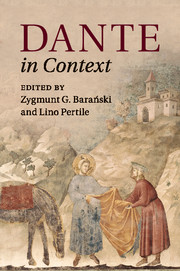Book contents
- Frontmatter
- Dedication
- Contents
- List of illustrations
- List of maps
- Notes on contributors
- Chronology
- Abbreviations and note on translations
- Introduction
- Part I Politics and society
- Part II Intellectual traditions
- Part III Linguistic and literary cultures
- Part IV Visual and performative culture
- Part V Dante: life, works, and reception
- 27 Life
- 28 Works
- 29 Textual transmission
- 30 Early reception (1290–1481)
- Further reading
- Index
27 - Life
from Part V - Dante: life, works, and reception
Published online by Cambridge University Press: 05 October 2015
- Frontmatter
- Dedication
- Contents
- List of illustrations
- List of maps
- Notes on contributors
- Chronology
- Abbreviations and note on translations
- Introduction
- Part I Politics and society
- Part II Intellectual traditions
- Part III Linguistic and literary cultures
- Part IV Visual and performative culture
- Part V Dante: life, works, and reception
- 27 Life
- 28 Works
- 29 Textual transmission
- 30 Early reception (1290–1481)
- Further reading
- Index
Summary
Very little is known with certainty about the life of Dante Alighieri. We do not have a single line, word, or signature written by him; nor do we have a single book or manuscript or object that belonged to him. The Casa di Dante that is shown to tourists in Florence was largely built in the early twentieth century in the area of the city where we know that the Alighieri had their houses in the thirteenth century. Archival documents concerning Dante are very rare too, except for the short period when he served in the Florentine government. Of the little we know about him, most is gleaned from indirect references scattered throughout his works, and hardly any of it is corroborated by independent sources. We must be even more cautious with Giovanni Boccaccio's (1313–75) Life of Dante, which is largely a fictional work, written around the middle of the fourteenth century.
Early life
Dante Alighieri was born into a modest Guelph family under the sign of Gemini, towards the end of May 1265, in the parish of San Martino del Vescovo in Florence, between the Duomo and Piazza della Signoria. He was probably baptized with the name of Durante, which later was shortened to Dante. We know that he was the only child of Alighiero di Bellincione degli Alighieri (d. before 1283) and Bella, probably the daughter of Durante degli Abati. Dante's mother died between 1270 and 1273, and his father married Lapa di Chiarissimo Cialuffi, of a very modest background, who bore him two children, Francesco and Tana (shortened from Gaetana). Documents mention another sister, though we do not know whether she was Bella's or Lapa's daughter.
The Alighieri were minor Florentine nobility who had seen their social status and economic position considerably reduced in the course of the previous two centuries. Dante's great-great-grandfather Cacciaguida (c.1091–c.1148) was knighted by Emperor Conrad III (1093–1152) and followed him to the Holy Land where he died fighting (Par. XV, 139–48). His immediate descendants were aristocrats who married into other families of similar social standing. However, Dante's grandfather and father clearly belong to a different, more modest social class of small businessmen and landowners. Bellincione, Dante's grandfather, was an active Guelph who was banished twice from Florence between 1248 and 1251 and again from 1260 to 1267.
- Type
- Chapter
- Information
- Dante in Context , pp. 461 - 474Publisher: Cambridge University PressPrint publication year: 2015

